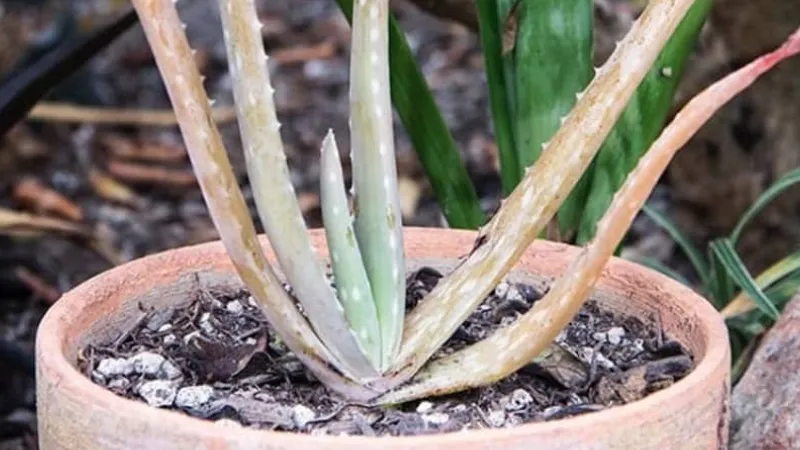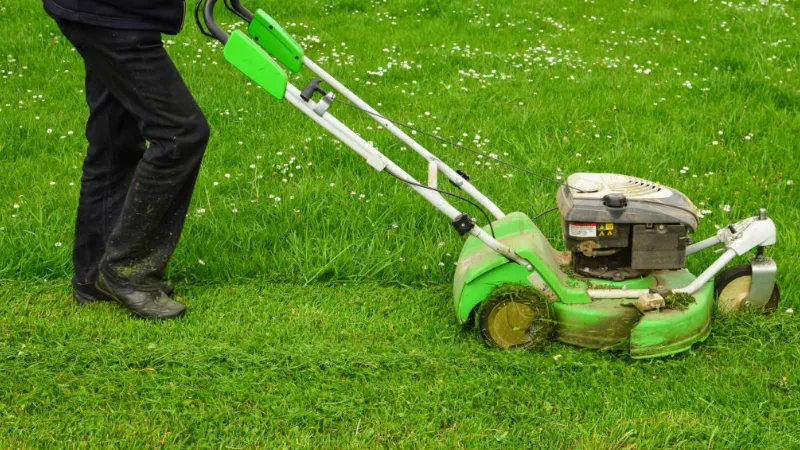Blue-green to gray-green is the color of healthy aloe vera plants. So, if your aloe vera is turning white, it’s a sign that something is off with it. Below will give you reasons “why is aloe vera plant turning white” and how to fix.
Why is Aloe Vera Plant Turning White? Over watering, too much sun or sudden changes in sun exposure, inappropriate temperatures or sudden changes in temperature, wrong soil type, and bad overwinter….
For more information, please keep reading.
Why is Aloe Vera Plant Turning White?
Here are common reasons why is aloe vera plant turning white:
Over Watering
Overwatering or very poor drainage is one of the most frequent causes of aloe vera plants turning white.
As aloe vera belongs to Succulents group they don’t like much water and it should have proper drainage, Aloe vera don’t like standing water.
Aloe vera should not be watered as frequently as other plants, nor should you assume that daily watering will result in fantastic growth.
There are two possible causes that you can over water
- Water very frequently (maybe daily)
- Overwatering might have occurred because you skipped watering for so long, among other possible causes.
above two cases you water it and you don’t have proper soil to drain well in this leads to problem for aloe vera plants
you see your plant has large or small colored spots that are squishy to touch then most likely your plant is suffering from an overwatering problem.
Before watering you need the check moisture level by keeping your fingers in the soil. If you feel sticky you should skip watering for that cycle.
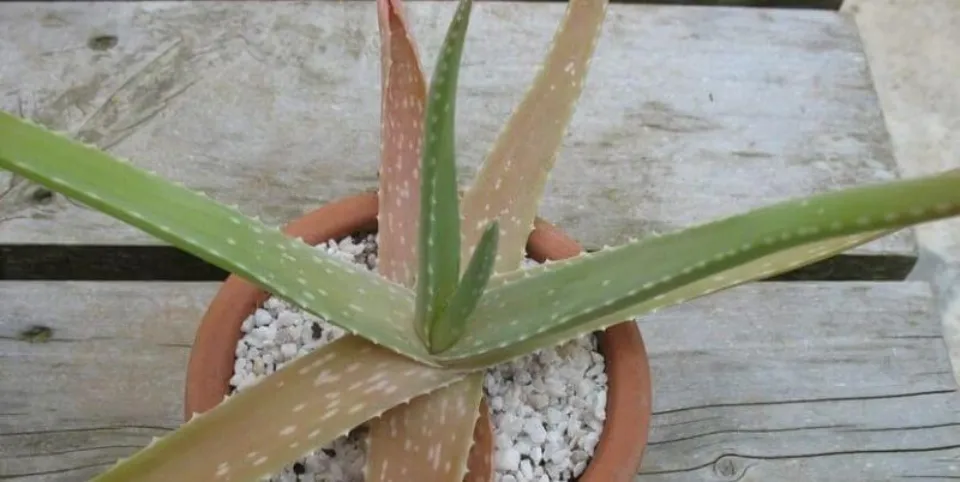
How to Fix the Overwatering Problems for the Aloe Vera Plant?
- Give the water that is there a chance to dry. Unload it if there is any standing water.
If this is the issue, it can be easily fixed. if you overwatered your aloe vera plant you need to take extra water out of it (from pot), and let it dry.
Avoid keeping your plant in direct sunlight while you are working on it; doing so will expose the roots to the sun. How much sun do aloe vera plants need?
In the interim (while it dries), you can prune the plant’s dead leaves.
- Give pot proper drainage holes and soil
Make sure the soil pot for your aloe vera plant can successfully drain the water. your pot don’t have drainage hole at the bottom of the pot.
Making a drainage hole is an option, as is moving the plan to a different area with suitable drainage and soil.
You should use a cactus soil mix or one part of builders sand, and the other parts use potting mix (you can also add use marble stones for aesthetics).
Overly deep pots can hold water for a longer period of time than ones that are narrower or wider.
When buying or making your own, you should essentially look for a wider pot with a lower height that is best for an aloe vera plant.
- Improve Watering habits
Aloe vera plant don’t need to water daily or alter days as other plants. if you are doing this your plant is being over watererd.
Before you water it again, you need to wait until the top 2 inches of soil are completely dry.
Most of the people choose to water aloe vera plant to every week or every 10 days. (depends on season).
According to experts, before watering an aloe vera plant, test the soil’s moisture content by burying your hand into it. If it is sticky, you must skip watering for that cycle.
Too Much Sun Or Sudden Changes in Sun Exposure
If you’ve noticed pale, almost white patches on your aloe plant, then, believe it or not, your desert plant might be suffering from a sunburn!
Your aloe probably won’t be able to tolerate full sun all day if it is in a hot environment (imagine the summer desert of Arizona).
Because they have shallower root systems than plants growing in the ground, this is particularly true for potted plants.
Aloe plants can become sunburned if they are exposed to direct sunlight or if they are moved from indoors to the outside.
This will make your aloe look like pale, almost white patches on the leaves.
On top of this, if you suddenly move them into hotter and sunnier conditions without an adjustment period, they can easily get fried from the sun and heat.
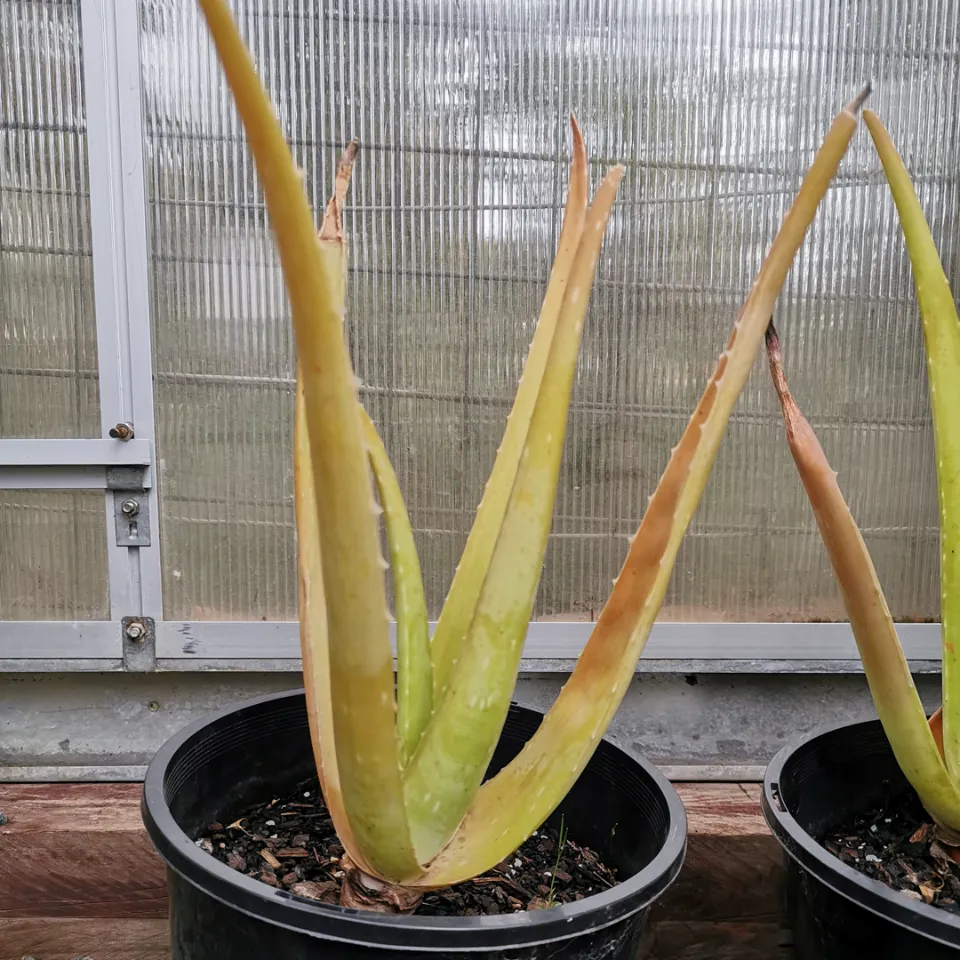
How to Fix Too Much Sun Or Sudden Changes in Sun Exposure for the Aloe Vera Plant?
Limit Sun Exposure: Your aloe plant may experience overheating if it is in a pot and is frequently exposed to direct sunlight.
Move it indoors, where it can still get sun while enjoying cooler temperatures, or to a location where it can have intermittent partial shade throughout the day.
In order to avoid damaging them, indoor aloes placed in front of windows facing the south and west should not sit directly on the sill. Back them up or move them to more indirect sun exposure, so they don’t get too hot.
Transition Period: If you’re shifting your aloe from a cooler, shadier position to one that is hotter and more exposed to the sun, do so gradually.
A few days of adjustment time are required for your aloe. So, begin in a shaded area and move them gradually into their final, sunny location. They’ll avoid getting sun-shocked this way!
Not Enough Sun
Aloe must have a lot of sunshine because it is a desert plant. You may notice the leaves wilting and becoming paler if your plant is confined indoors, placed far from a window, or placed in a shaded area of your yard.
This may be why your aloe leaves appear whiteish. Etiolation is the term used to describe what happens when a plant does not receive enough sunlight to grow.
How to Fix Not Enough Sun for the Aloe Vera Plant?
Change Locations: Your aloe plant should be moved to a more sunny spot. If it is indoors, you can place it directly in a window that faces North or East or close to but not in a South or West window.
Pick a location that experiences some afternoon shade. Your aloe might grow in full sun if the climate where you live is a little more temperate.
Inappropriate Temperatures Or Sudden Changes in Temperature
Both abrupt temperature changes and abrupt changes in sun exposure can bejare your plant. If leaves are exposed to extreme cold or heat, they may dry out and turn brown or pale.
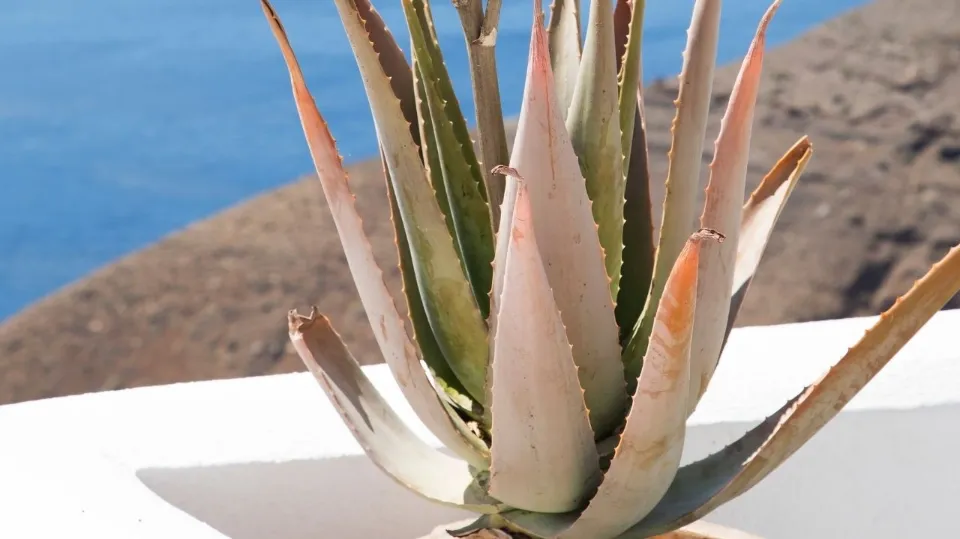
How to Fix Inappropriate Temperatures Or Sudden Changes in Temperature for the Aloe Vera Plant?
Never leave your aloe outside in temperatures below 50°F (10°C). You won’t need to be concerned about this if your aloe plant is indoors.
Monitor Outside Temperature: If you live in an area with regular-season changes, move your aloe plant inside when the weather becomes cold and wet. Remember, do this gradually over a few days.
Give them some time to adjust before bringing them back outside for the summer.
When the weather is cooler, especially at night, cover your aloe with blankets if it is permanently rooted in the ground outside and cannot be moved.
Avoid Hot Windows:placing an aloe plant directly against a It may become too warm if there are windows that face south or west.
Your aloes should be placed in a window that faces north or west, or if they must face south or west, move them back about a foot from the windowpane.
Wrong Soil Type
If you’ve tried everything else and your aloe is still giving you trouble, the soil it’s growing in could be to blame.
Aloes are tropical or subtropical succulents (depending on the breed), and therefore don’t do well in typical potting soil.
For instance, you cannot grow pansies or daylilies in the same soil that you grow aloe in because the soil typically retains too much moisture and/or has too many nutrients. Aloe leaf whitening may result from either of these factors.
How to Fix Wrong Soil Type for the Aloe Vera Plant?
Get a Cactus or Succulent Mix:Choose a soil that is designed specifically for succulents or cacti.
Because of the aerated soil, water can drain quickly and effectively, protecting your aloe from drowning. It won’t contain an excessive amount of nutrients, either.
Prepare Your Aloe for Repotting:Prior to repotting your aloe, make sure it has received adequate water for 2-4 days.
Repot it in the new soil, barely covering the rootball, after carefully removing it while taking care not to damage the plant’s roots.
The roots’ ability to breathe will be compromised if the rootball is buried too deeply in the ground.
Thoroughly water your aloe once it is repotted to help the roots establish themselves in the soil.
Your plant might be shocked by the repotting and exhibit some discoloration for a short while.

Bad Overwinter
In winter, succulents will naturally go dormant and their growth comes to a natural stop.
If, after bringing your aloe indoors, you actively watered it or, even worse, fertilized it, your aloe plant continued to grow and skipped the dormant stage.
Aloe vera’s leaves may turn white as a result of having to grow in a limited amount of light with few resources. On new growth, white leaves will stand out in particular.
How to Fix Bad Overwinter?
Start by ceasing to fertilize and drastically reducing watering. Only fertilize aloe vera plants in the spring and summer, when they are actively growing.
And even then once a month is plenty. Use fertilizer that has been designed with succulents in mind. As the fall sets in, skip fertilizing and only resume in spring.
You can continue to water your aloe vera; you just won’t need to do so as frequently. Your aloe uses fewer nutrients and less water during the winter. In the winter, less watering is required because evaporation is slower.
Fertilizer Or Salt Build Up in Plant
Around the aloe plant’s top layer of soil, salt and fertilizer can accumulate over time or with heavy use.
The life processes of plants require certain minerals like potassium, phosphorus, and nitrogen. Due to chemical activity in the soil, minerals there are transformed into chemical salts. By microbial population of soil these can be added by fertilizer.
You can see the top layer of soil forming a white, thin crust of residue when using heavy fetilizer.
You can also see some root damage from increased fertilizer use with salt build-up (in white color).
Low chlorofyll levels caused by nitrogen deficiency cause aloe plants to turn white.
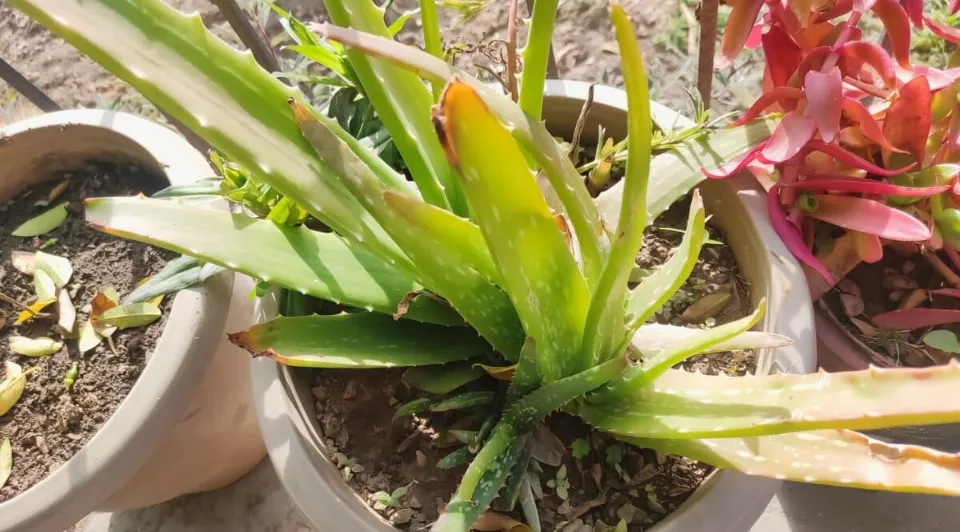
How to Fix Fertilizer Or Salt Build Up in Plant?
- Remove mineral crust – Removing minerals
The first step is to use your fingernails or another material to scrape the extra minerals from the plant.
In order to remove additional minerals, you must later leach the soil, which requires running five times as much water through it as the pot can hold.
- Remove excess fertilizer – Removing excess minerals
Once you scrape off the excess minerals or crust from plant/pot. you need to remove the excess fertilizer from pot.
To wash out the extra fertilizer or minerals, you must use five times as much water in the pot.
Indoor plants don’t require frequent fertilization; it all depends on how much light they receive.
Plants with high light need 3-4 times of fertilization. plants with medium-light need only twice a year. Low light plants need only once a year(with yearly once repotting)
1-2 fertilizations should be given to plants like aloe vera annually, most likely in the spring.
- Use pure water – Reducing minerals in water
use mineral water to water plants because tap water contains many minerals like chlorine and additives.
The minerals in water can be removed using an external water filter.
A more cost-effective alternative if you don’t have mineral water is to collect the rainwater that would otherwise fall on an aloe vera plant.
- Don’t over fertilize – Only once in spring
Aloe vera plants prefer fertilization, as we previously discussed, between 1-2 times annually. If you fertilize too much, your plants or the topmost soil will develop a thin crust.
Nutrients Deficiency
Aloe vera plants will turn white if they lack sufficient nutrients. The aloe vera plant is well known for requiring little upkeep and growing in unfavorable soil.
Low nutrient levels can still cause problems for plants. Due to the lack of nutrients, aloe cannot produce chlorophyl for which nitrogen and magnesium are required to process.
How to Fix Nutrient Deficiency in the Aloe Vera Plant?
select proper fertilizer and soil, use the soil which is made for succulents. you need use cactus soil or one part of pot mix and builders sand for other part to aloe vera plant.
Experts suggest a liquid 10-40-10 mix of fertilizer or a special fertilizer that is made for succulents.
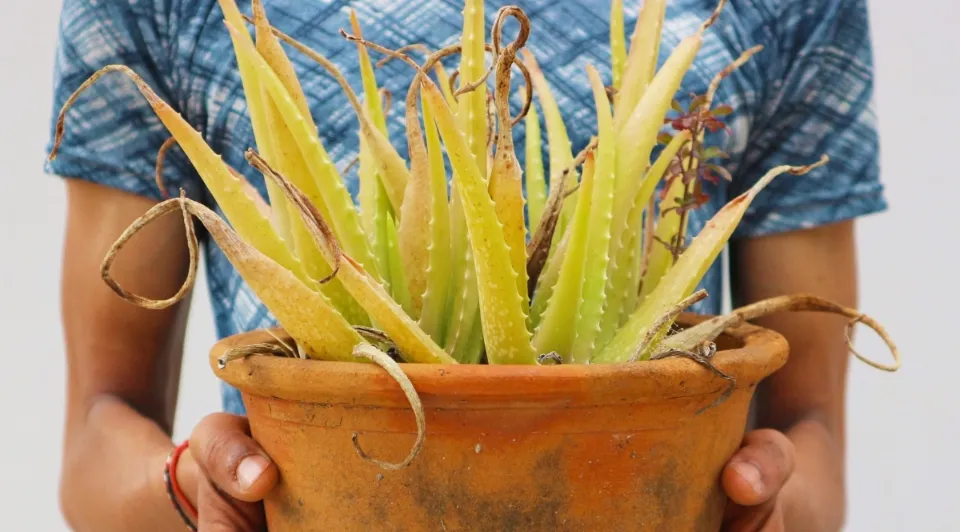
Too Much Nutrients
What just happened is exactly the opposite of this. The overfertilization of aloe vera plants often results in an excess of nutrients.
How to Fix Too Many Nutrients Problem for the Aloe Vera Plant?
- Remove excessive nutrients
Aloe vera may appear to be turning white if you have already fertilized excessively. So, we must flush 5 times the volume of a pot of water to remove extra nutrients.
- Don’t over Fertilize
Fertilize only in the spring and once a year to combat overfertilization. To know if the plant is over fertilized, the white layer thin crust is formed on top layer of soil or plant.
to make overcome this need to scrape the white layer and water the pot to remove the excess fertilizer.
Wrong Mix of Dirt (Soil)
Did you try all the things above and still you did not find the remedy for your plant then the culprit is the soil mix.
Aloe is a succulent and does not grow well in potting soil.
How to Fix Wrong Mix of Dirt for the Aloe Vera Plant?
For best results, water the plant for two days prior to repotting, avoid shocking the plant, and prepare the soil by performing the following steps before you begin.
you need to select cactus soil for potting aloe. Adding one part of the soil mix and the other part of builder soil is required if you are creating your own soil mixture.
you can add marble stones on top of the soil to look nice (aesthetics).
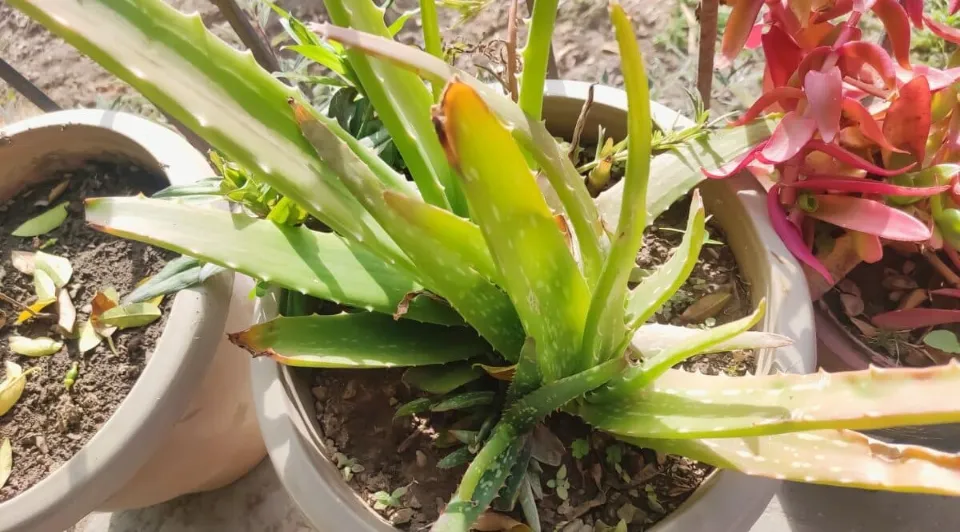
Pests
Aloe leaves can also become discolored and occasionally turn pale due to pests that feed on sap, though they are less frequent. These pests include mealybugs and aphids.
The spread of some pests can be aided by excessively dry air or moisture on the leaves. To keep pests under control, you can use a rubbing alcohol and water solution to wipe them off the leaves of your aloe.
How to Fix Pests for the Aloe Vera Plant?
Neem oil can be sprayed on your aloe vera to help with fungal leaf problems as well as pest control.
Keeping leaves clean and dry can help prevent many pest or fungal issues.
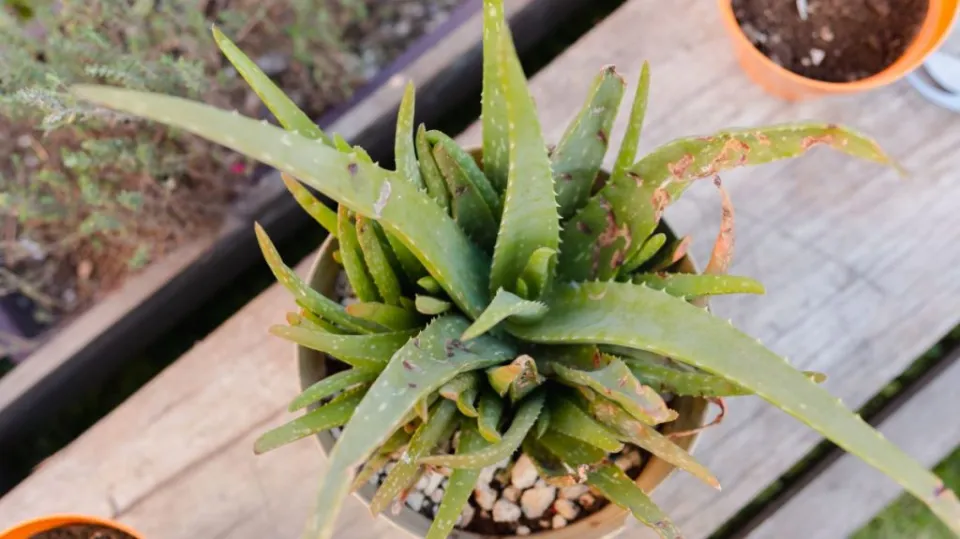
FAQs
Why is My Aloe Losing Color?
When Aloe vera plants are overwatered, the leaves will fade in colour, yellow, brown off and eventually rot away. It is quick and simple to check for overwatering: if the plants are in the ground, push a garden hand trowel into the soil and see if the soil is wet.
Do Aloe Plants Need Direct Sunlight?
It is critical that you place your aloe in a window where it will receive a minimum of six hours of sunlight per day. Your succulent will start to stretch and lose its attractive, compact form in the absence of prolonged, direct light. As the stem ages, it might collapse.
How Often Should Aloe Vera Be Watered?
Deep, but infrequent, watering is necessary for aloe vera plants. Allow the soil to dry at least 1 to 2 inches deep in between waterings to prevent rot. Keep your plant out of water at all times. Water about every 3 weeks and even more sparingly during the winter.
Where is the Best Place to Put An Aloe Vera Plant?
A south facing window is the ideal spot for an indoor aloe plant, but they also grow well under artificial lights. A grow light is a must if your home isn’t bright enough to grow plants in. They will develop most effectively outside in full sun.
Summary: Why is Aloe Vera Plant Turning White?
Whitening aloe vera leaves are a simple and low-effort fix. Make a few adjustments to your daily care routine, it’s not a big deal.
Give proper light and water to your plant and it will stay green and lush.
If you have any questions, please leave a comment. My Prime Home tries to give you the best home improvement information. Don’t forget to share the post. Thank you for reading.
You may also interested:
